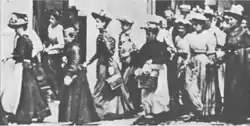Luis Manuel Méndez
Electric business
Méndez worked as a representative for the American Telephone Company across the west of Venezuela, operating in Maracaibo, San Antonio del Táchira, Cúcuta (in present-day Colombia) and San Cristóbal.[1] Venezuelan film scholar Arturo Serrano, therefore believes that his interest in starting a film business was not new or unexpected when he traveled to New York in 1896.[1] In this capacity, he operated the Maracaibo Telephone Company, opening telephone lines in the city on 5 November 1888 with an initial 50 connected devices.[2]:2021
Bringing cinema to Venezuela
Vitascope deal
In 1896, Méndez was tasked with bringing electricity to the state of Táchira, and took a trip to New York City for information. It was while he was in New York that early demonstrations from competing cinema companies took place; Méndez was inspired to get into the business, which he saw to be profitable, and made a deal for distribution rights with the Vitascope across both Venezuela and neighboring Colombia.[3]:42-43 Méndez paid $750 on 10 June, becoming the first foreign deal for the Vitascope;[4] he received Vitascope number 25, and returned to Venezuela later that month.[3]:43
For many years[note 1] records instead indicated that the Vitascope was introduced by contemporary Manuel Trujillo Durán, whom Méndez employed at the time.[7] Though Trujillo, a photographer, had connections to the Edison Company, Méndez had his own with the Kinetoscope Company, which produced and traded the Vitascope.[4][5] It was later when the travel records of Méndez' visit to the United States were discovered was his role widely acknowledged.[5]
Screenings and distribution

When Méndez brought the technology to Venezuela, it allowed him to show films in the country for the first time; he hired Trujillo to set up a show in Maracaibo, playing four shows over a few days.[3]:42-43[8] What was thought to be the first film screening in Venezuela was held on 11 July 1896,[3]:43 a fact discovered in documentation found at Harvard in 1991.[9] This show was held in the Baralt Theatre, where the first Venezuelan-produced films would be shown the next year, with tickets costing 1 bolívar in the stalls and 20 bolívares in the balcony.[3]:42-43 However, the Kinetoscope Company had already presented the Kinetoscope in the country in 1895,[3]:42 and shown at least one film, with another report suggesting a film was shown in Venezuela as early as 24 September 1894.[3]:44
However, these did not show the breadth of films Méndez licensed from 1896, nor show them as widely.[3]:44 After the screenings in Maracaibo, Trujillo was put under contract by Méndez to take the projector around Venezuela and Colombia, distributing and marketing films.[8] He originally returned to Maracaibo in November 1896 after touring Venezuela and with a collection of new films that he wished to show, but was sent to Colombia instead.[3]:45
The first film produced specifically for the Vitascope was known as The Monroe Doctrine or the alternate title Venezuela Case in the United States,[note 2] where it was made, and as Alegoría sobre la doctrina de Monroe in Venezuela.[3]:44 The film was a satirical take on the auspices of the Monroe Doctrine, and presented Venezuela in a positive light.[3]:44[10] The Venezuelan audience were said to be "moved" by the depiction of their complicated political reality on international film.[3]:44
Notes
- Film scholarship in Venezuela began in about the late 1970s, with documents produced from the early 1980s.[5] Some early Venezuelan "scholarly" documents, like film critic Izaguirre's essay/article from 1984, mention the then-accepted Trujillo narrative when contextualising other topics.[6]
- See Monroe Doctrine at IMDb.
References
- "Los heroes del cine venezolano (Parte I)". ViceVersa Magazine (in Spanish). 10 November 2014. Retrieved 14 September 2019.
- Semprún Parra, Jesús Ángel; Hernández, Luis Guillermo (2018). Luis Perozo Cervantes (ed.). Diccionario General del Zulia (in Spanish). Vol. 1. Sultana del Lago. ISBN 9781976873034.
- Muñoz, Lionel, ed. (August 2009). "Inicios del cine en Venezuela". Memorias de Venezuela / Origenes del Anticomunismo en Venezuela (in Spanish). Vol. 10. Fundación Centro Nacional de Historia. pp. 40–45. Retrieved 14 September 2019 – via Issuu.
- Ramsaye, Terry (1964) [c. 1954]. A million and one nights a history of the motion picture. London: F. Cass. p. 279. ISBN 9780203042069. OCLC 1086433556.
- Serrano, Arturo. "The Beginnings of Cinema in Venezuela: The arrival of Cinema in Venezuela (1896–1907)". Universidad Católica Andrés Bello. Retrieved 14 December 2018.
{{cite journal}}: Cite journal requires|journal=(help) - Izaguirre, Rodolfo (1984). La integración cinematográfica iberoamericana. La utopía al alcance de los cineastas (PDF) (in Spanish) (73 ed.). Nueva Sociedad. p. 85. Retrieved 15 December 2018.
- Zulia State Council. "Historia de Manuel Trujillo Durán" (in Spanish). Consejo Legislativo del Zulia. Retrieved 27 October 2017.
- Iribarren. "IRIBARREN Films: Érase una vez unos muchachos bañándose en la laguna de Maracaibo". IRIBARREN Films (in Spanish). Retrieved 12 September 2019.
- "Día Nacional del Cine Venezolano". El Zuliano Rajao. Retrieved 2019-09-14.
- Brown, Richard (2017). The Kinetoscope: a British History. Musser, Charles; Harvey, Michael; Anthony, Barry. Baltimore, Maryland: Project Muse. pp. viii. ISBN 9780861969319. OCLC 1005225000.